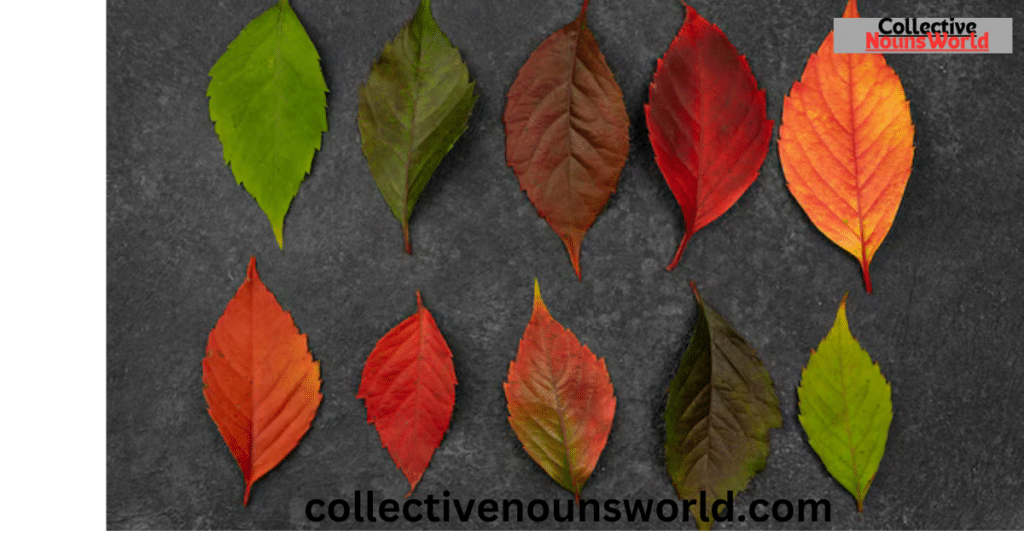When it comes to the plural form of “leaf,” many people find themselves caught in a confusing debate: leafs or leaves? This seemingly simple question often leaves even native speakers uncertain about the right choice. However, understanding the difference is more than just a matter of grammar—it’s about clarity and correctness in communication.
Whether you’re writing an essay, chatting with friends, or reading about nature, knowing when to use leaves instead of leafs can make all the difference. Dive into this topic, and you’ll quickly master the rules that will help you sound more confident and precise in your writing and speech.
What is the Plural of “Leaf”? Is it Leafs or Leaves?
The confusion between “leafs” and “leaves” is a common issue in English. To put it simply, the plural of leaf is leaves, not leafs. Even though “leafs” is sometimes heard, especially in sports, leaves is the grammatically correct plural form. This rule applies to most nouns in English, where an -s or -es is added to form the plural.
The difference between the two words is especially important for people learning English grammar rules. If you are a native speaker or a student, using the wrong form can affect the clarity of your speech or writing. Understanding the right form of plurals is important not just for learning but also for communicating clearly in everyday language.
Leaves is the Grammatically Correct Way to Spell the Plural of Leaf
In standard English usage, the plural form of leaf is leaves. This follows regular pluralization rules that apply to many English nouns. The pluralization of “leaf” involves adding -ves to the singular form. This change from “f” to “v” in the plural form is a typical pattern seen in morphology. Other examples include knife turning into knives or wife turning into wives.
This pattern of changing “f” to “v” and adding -es is deeply rooted in English’s linguistic history. It evolved over time as the language developed from Old English to Modern English. According to Merriam-Webster, the use of “leaves” is consistent with English’s rules for changing nouns with an “f” ending into their plural forms.
Why We Use “Leaves” as the Plural of Leaf
The reason leaves is used as the plural of leaf goes back to the linguistic theory of noun inflection. In English, certain nouns undergo a morphological change when they are pluralized. The shift from “f” to “v” is one such morphological irregularity that happens to many nouns ending in “f.” This rule is grounded in the historical evolution of the language.
The etymology of “leaf” and its plural form, “leaves,” shows that English speakers have followed these pluralization rules for centuries. While the form “leafs” may appear in some contexts, it is not the preferred way of forming the plural.
Read more about Feal vs. Feel Explained: Master These Confusing Words in Minutes
Deep Dive Into Usage: Leafs vs. Leaves
While leaves is the correct plural in almost all cases, there are exceptions. One of the most famous exceptions is in the name of the Toronto Maple Leafs, the hockey team. This is a special case in English, where the plural “leafs” is used for a sports team name. Even though “leafs” is not grammatically correct in other contexts, it is accepted in sports team names and other proper nouns.
In most other situations, leaves should be used. You would say, “The leaves of the trees were turning yellow,” or “I found some beautiful leaves in the forest.” Using leaves in nature, literature, or general speech is the standard, and it follows pluralization rules.
Side-by-Side Comparison: Leafs vs. Leaves
When deciding whether to use leafs or leaves, the context is key. Here is a quick comparison of when to use each form:
| Context | Leafs | Leaves |
| Nature | Not used | Used to refer to plant or tree leaves |
| Literature | Not used | Used metaphorically in writing (e.g., “turning the leaves of history”) |
| Sports Teams | Used (e.g., “Toronto Maple Leafs”) | Not used |
As shown, leaves is the correct form in nature, books, and plants, while leafs is only appropriate in very specific proper noun situations like sports teams.
Read more about Reinforce vs Reenforce: Simple Guide [2024]
Pronunciation of “Leaves” and “Leafs”
Pronouncing “leaves” and “leafs” might seem tricky, but they have almost the same pronunciation. The main difference is in the way you pronounce the ending of each word. Leaves ends with the “v” sound, while leafs ends with an “s” sound. In everyday speech, both words might sound quite similar, but leaves is the most commonly used form and is pronounced with a soft “v” at the end.
It’s important to note that many English learners may mispronounce “leaves” as “leafs” because they sound alike, but with a little practice, it becomes easy to distinguish them.
How to Pronounce “Leaves” Correctly
To pronounce leaves correctly, focus on saying the “v” sound clearly at the end of the word. It should sound like “leevz” with a soft “v” rather than “leafs,” which has a hard “s” sound. This is one of the more common mistakes, especially among non-native speakers, but with a bit of attention to the pronunciation, it becomes second nature.
Is “Leafs” Pronounced Differently from “Leaves”?
While both words might sound similar in casual speech, there is a subtle difference in pronunciation. Leafs has an “s” at the end, while leaves has a “v.” The difference is minor but noticeable. For example, “leaves” sounds like “lee-vz,” while “leafs” sounds like “lee-fs.”
Read more about Excel or Accel: Which is Correct?
Examples of How to Use the Plural Tense ‘Leaves’ as a Noun
To see leaves in action, consider these sentences:
- “The trees dropped their leaves in autumn.”
- “I found some colorful leaves on the ground.”
- “The leaves rustled in the wind.”
As you can see, leaves is used in a variety of contexts, from describing nature to being used in literature.
Leaves in Nature
When talking about nature, leaves are the flat, green parts of plants and trees that photosynthesize. The plural form leaves is used when referring to these parts, as in “The tree’s leaves changed color in the fall.”
Leaves in Literature
Leaves can also be used metaphorically in literature. For instance, authors often refer to turning the “leaves” of a book or describing leaves in poetry to symbolize change or passage of time.
Read more about Cacoon or Cocoon: Which is Correct?
Grammar: Why Is “Leaves” the Correct Plural Form?
The grammar rule for pluralizing leaf is straightforward. English uses the pluralization rule that changes the “f” to “v” and adds -es to form leaves. This follows the same rule as many other nouns that end in “f,” like knife to knives and wife to wives. This morphological rule ensures consistency in the way nouns are pluralized in English.
When to Use “Leafs”
The term leafs is only used in a few exceptional cases. The most notable example is the Toronto Maple Leafs, where “leafs” is used because it is the name of a sports team. In other instances, leafs is not the correct form, and leaves should be used instead.
Leafs (Proper Noun)
In the case of sports team names, leafs is used as a proper noun. This exception to the rule doesn’t follow standard pluralization and should be remembered as an exception rather than the rule.
Conclusion
This is the grammatically correct plural form of leaf in most contexts, following the standard rules of pluralization in English used in literature and everyday speech as much as it is in nature. Leafs is a variant, mainly used in proper names, such as Toronto Maple Leafs.
Knowing how to use leaves and leafs can end confusion. When you are using them correctly, you are more likely to sound natural and professional in your writings and conversations. Remember always that leaves is your go-to plural except when it comes to special cases, like sports teams.

Luna Jasper is an experienced blogger with a passion for language and grammar. At **Collective Nouns World**, she shares her expertise in exploring the fascinating world of collective nouns, making learning both engaging and fun. With years of writing and research under her belt, Luna’s insightful articles help readers understand and appreciate the English language.







